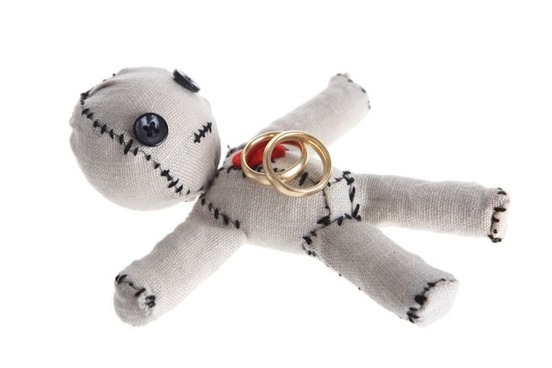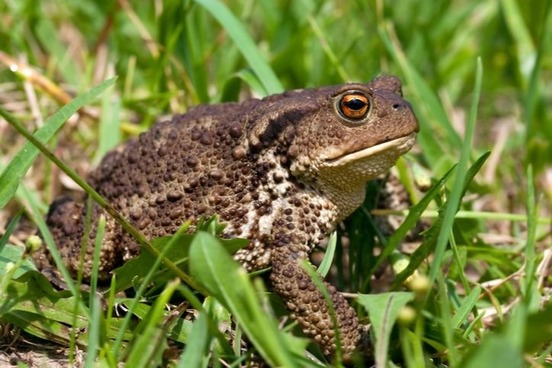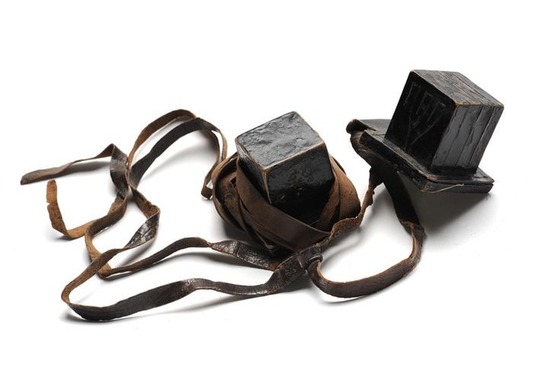
Mascot
The ancestor of mascot is the Latin word masca, which in the Middle Ages meant "witch." Masca was borrowed as masco into Provenҫal—a dialect of southern France—and, later, as mascoto, a diminutive form of the Provenҫal noun that was used to mean "charm" or "magic spell." In the latter half of the 19th century, the diminutive became part of modern French as mascotte, meaning "good luck charm," and was popularized in the title of the operetta La Mascotte, composed by Edmond Audran in 1880.
In this operetta la mascotte is a beautiful, young woman named Bettina, whose beneficent influence brings victories to the army of the prince of Pisa. The appearance of mascot in English followed soon afterward, when it was used generically to mean "a person, animal, or object held to bring good luck." Today, many schools, sports teams, and other organizations have mascots as a symbol of good luck—as well as an enticement to sell merchandise and services.

Jinx
Most of us are familiar with the children's game of jinx, in which the word jinx is called out when two people unintentionally say the same thing at the same time. The first to call out the word avoids the "jinx" (or "curse") whereas the other is caused to endure some form of "torture"—oftentimes, it's not being allowed to speak until somebody says his or her name, or owing the other person a Coke.
Etymologists aren't exactly sure how the word jinx developed. The word is suspected to be an alteration of jynx, the name of the wryneck woodpecker that populates Eurasia and Africa. The bird is so named from its peculiar behavior of snakily writhing its neck when alarmed. In medieval times, this odd bird was thought to have occult powers and was used in witchcraft, divination, and magic. In time, the name jynx came to be associated with bad luck. Etymologically, this sounds convincing—however, evidence of the first use of the word doesn't corroborate this theory.
Use of jinx in English dates to the beginning of the 20th century as an American slang term in sports—in particular, baseball.
Of course everyone has heard what a baseball jinx is. It is more popularly known to the layman as a hoodoo, but the ball players themselves call it a jinx. Bob Enos avers that Owner Annis appears to be the jinx of the local club and that the players are getting so that they hate to have him meet them on the road.
— The Fort Wayne Sentinel, 17 June 1910A jinx is something which brings bad luck to a ball player.
— Christy Mathewson, Pitching in a Pinch, 1912
But in earlier citations of the word, the spelling jinks is found.
Anyone who can furnish reliable information leading to the conviction of the miscreant who put a "jinks" on the Los Angeles baseball club’s batting eyes last spring will likely receive a free pass for the rest of the season by advising Manager Morley.
— The Los Angeles Times, 12 Jul. 1904The Cincinnati team has done with Mike Donlin for good, and it is not likely that this ex-Californian will cut much ice from now on. That term in jail put the jinks on Donlin.
— The Los Angeles Times, 11 Aug. 1904
The sudden shift in spelling from jinks to jinx is hard to explain, as is how the name of a nonnative bird associated with medieval sorcery nestled into the slang of early 20th-century American sports.
With this in mind, some etymologists have proposed a different origin of the word: a late 19th-century musical comedy called Little Puck, which features a character named Jinks Hoodoo, who evidently is cursed with bad luck. The theory has some weight and is backed by print evidence, but the question remains as to why the preference in spelling changed from jinks to jinx in the early 1900s.
(By the way, the jinks in high jinks is unrelated. Read that word's history here.)

Voodoo
The word voodoo is from Louisiana French voudou, which is related to the African word for a spirit or deity (vódũ). For many, the word conjures up an old serial image of a witch doctor sticking pins in a doll, while miles away an innocent, unwitting victim writhes in pain; or we think of zombies stalking the earth in search of human blood. With this tendency to associate voodoo with evil, it may surprise some to learn that it is a religion which combines elements of Roman Catholic ritual with elements of native African religions and magic.
Voodoo is practiced throughout the Caribbean and South America as well as in parts of the United States. A basic tenet holds that the spirits of the dead can be called into the world of the living to bless or curse people—it's the latter aspect that has been popularized in books and movies. One way to call one of these spirits into action is to create an image (such as a wax doll) of the person who is the object of a curse or blessing, and treat the figure as you would like that person to be treated by the spirits. From this practice derives the image of the voodoo doll used to inflict harm on one's enemies.
The word voodoo eventually became associated with unexplainable phenomena in general. For example, the term was used during the 1980s in U.S. politics to describe a proposed economic policy as "voodoo economics."
Most people believe this new approach to economic policy is based on the proposition that tax cuts pay for themselves by stimulating the economy. ... Since this theory implies that government can cut taxes and keep on spending, it has widely been denigrated as ... "voodoo economics" —Paul Craig Roberts, Business Week, 12 Nov. 1984
Hoodoo is related. It is believed to be an alteration of voodoo and similarly refers to magic or bad luck of some kind; however, the word also has a unique sense referring to natural columns of rock having a fantastical form created by erosion.
In the Hoodoo Valley the erosion has left strange pillars of stone called hoodoos, topped by larger boulder caps that teeter on top.
— Horace Sutton, The New York Herald Tribune, 25 Apg. 1963Silhouetted on the side of the canyon, hoodoos—huge mushroom-like stands of caprock—are rigid sentinels….
— John Hemingway, Town & Country, July 1980

Toadstone
Although modern science has dispelled the magic of toadstones, their history still fascinates. Toadstones come from bufonite, a fossil consisting of the petrified teeth and jawbone of a fish—specifically, an extinct fish of the genus Lepidotes that was common in the Jurassic and Cretaceous periods. Considering that the teeth give a bumpy surface to bufonite, one can see how it might become associated with the toad in appearance, as it does resemble its warty skin.
As was common in the dark ages of science (during which fossils were studied by sorcerers, not anthropologists), association led to ideas. In this case, since the stones resembled the bumps on a toad, it was conjectured that they must come from a toad … and are probably found in its head. In addition, since toads were believed to have poisonous glands—naturally—they carried their own antidote and, perhaps, the antidote was the stone.
Indeed, people did come to believe that the toadstone could detect poison or counteract its effects. Supposedly, the stone would sweat, change color, or heat up in the presence of poison, and when placed on a bite, it would extract the poison. Inevitably, this magical stone was fashioned into charms, amulets, and other types of wearable decoration. William Shakespeare alludes to the fabled toadstone (and the general dislike for toads) in his comedy As You Like It:
Sweet are the uses of adversity, / Which, like the toad, ugly and venomous, / Wears yet a precious jewel in his head.
Now, you may be wondering how exactly this "precious jewel" was extracted from the toad in ancient times. First, the toad must be alive in order to retain the stone's magic. Second, you need a red blanket. Apparently, the toad likes red and likes to stretch out; when it is relaxed, it will belch out the stone:
But the Art (as they terme it) is in taking of it out, for they say it must be taken out of the head alive, before the Toade be dead, with a peece of cloth of the colour of redde Skarlet, where-withall they are much delighted, so that they stretch out themselves as it were in sport upon that cloth, they cast out the stone of their head, but instantly they sup it up againe, unlesse it be taken from them through some secrete hole in the said cloth, whereby it falleth into a cesterne or vessell of water, into which the Toade dareth not enter, by reason of the coldnes of the water.
— Edward Topsell, The History of Serpents, 1608
Or you could just place a toad in a pot full of ants:
Put a great or overgrowne Tode ... into an earthen pot, and put the same in an Ants hillocke, and cover the same with Earth, which Toade at length the Ants will eate. So that the bones of the Toade and stone will be left in the Pot....
— Thomas Lupton, Thousand Notable Things, 1576
Now go thank your nearest medical professional.

Phylactery
In Judaism, phylactery (or in Hebrew: tefillin, tephillin, or tfillin) refers to one of two small, leather, cube-shaped cases containing scriptural passages written on parchment, which are worn as reminders of God and of the obligation to keep the Law during daily life. The word is derived from Greek phylaktērion, meaning "amulet" or "safeguard," and you may occasionally encounter phylactery as a synonym of amulet.
It includes six gold necklaces, decorated with emeralds, sapphires, garnets, and pearls, a necklace of gold coins, a phylactery (amulet), three bracelets made of gold plate, six rings, five pairs of earrings, six intalgios, and a cameo.
— Daniel Hourquebie, The Guardian Weekly, 14 Feb. 1993
In the past, phylactery was also the name for a case or chest enclosing a holy relic (such as a bone of a saint). That sense is now considered obsolete; however, a modified version of the sense is popular in the realm of fantasy gaming and fiction where it refers to a container for souls and élan vital rather than decaying remains:
If a lich's physical form is destroyed, it reforms at the location of its phylactery in 1d10 days. However, if the phylactery is found and destroyed, the lich's life force is released, forcing it to move on to its eternal damnation.
— Rodney Leary et al., Classic Fantasy: Dungeoneering Rules for Percentile Roleplaying, 2016

Mojo
Although mojo is a magical word of African voodoo roots that refers to spells, hexes, or charms, it is one that English speakers and writers aren't afraid to play with.
"Willett, that's a … fantastic story.... But what does that have to do with the sixteenth hole?" "'Cause the green of number sixteen sits on top of the spot where Reverend Sonny Boy's church melted." "Does this mean that number sixteen … has a mojo on it?"
— Jimmy Buffett, Tales from Margaritaville, 1989
The word is related to the Gullah creole word moco, meaning "witchcraft, magic," and the Fulani word moco'o, "medicine man." It was introduced into American slang through early 20th-century writings on African-American folklore and was popularized by blues and jazz artists, such as McKinley Morganfield (a.k.a. Muddy Waters) and his 1957 song "Got My Mojo Working."
Nowadays, mojo has more to do with working personal charm and charisma than with working voodoo magic.
I wonder what brand of mojo he's pumping at those Sunday meetings?
— The Saturday Evening Post, 13 June 1953…he works the audience with all the masterful puppeteer mojo of the Merlin he often poses as.
— Lester Bangs, Psychotic Reactions, 1973

Madstone
The madstone is a 19th-century American version of the bezoar stone. (Bezoar is derived from Persian pād-zahr, meaning "protecting against poison.") Both are hard substances formed in the digestive system of an animal that, according to folklore, can counteract the effects of poison (as from the bite of a venomous snake or a rabid dog). The most common madstone is a solidified hair ball formed in the stomach of a deer (a bezoar is more likely formed inside the stomach of a goat or an antelope).
American traveler Henry Knight gives us a description of the stone in a letter from 1816, which he sent while in Virginia: "a reputed remedy against canine rabiosity; two mad-dog stones, of long extolled efficacy…. The stones are about an inch and an half cube; resemble a piece of hone, or hard soap; and are powerful astringents and absorbents. When put into warm water from the wound, they discolour it with matter drawn from the blood."
In his 1931 biography of Abraham Lincoln, American poet Edgar Lee Masters reports that Lincoln took one of his sons to Terre Haute, Indiana, to have a madstone applied to his wound inflicted by a rabid dog. Lincoln wasn't unprecedented in his journey to Terre Haute; others made the pilgrimage. Apparently, if you were in possession of a madstone that had proven results, you should expect visitors.

Juju
Juju is a West African word from the Hausa language of northern Nigeria that appears in English in the late 1800s and refers to a type of spiritual magic that can be used for benevolent or nefarious purposes. The magic operates on the principle that spiritual energy can be imparted to objects. These objects are called jujus and are thought to ward off evil; they can also be infused with energy that brings good luck or misfortune to a person.
In the mid-20th century, another juju, derived from another language, Yoruba, appears in English. It refers to a style of West African music that blends Christian congregational singing, Yoruba vocal and percussion traditions, and assorted African and Western popular genres. Juju's heyday was in the 1980s when world music had a surge in popularity.
Also in the mid-20th century, juju was heard as a slang term (developed through reduplication of the digraph "ju" in marijuna) for a marijuana cigarette.
"I knew a guy once who smoked ju-jus," she said. "Three high balls and three sticks of tea and it took a pipe wrench to get him off the chandelier."
— Raymond Chandler, Farewell, My Lovely, 1940

Mumbo jumbo
The history of mumbo jumbo can be traced back to Africa. Etymologists speculate that it comes from the Mandinka word maamajomboo, the name for a masked dancer who took part in religious ceremonies. Early evidence of the word comes from Francis Moore, who was a clerk with the Royal African Company, in his 1738 book Travels into the Inland Parts of Africa. In the book, Moore recounts how he "was visited by a Mumbo Jumbo, an Idol, which is among the Mundingos a kind of cunning Mystery." He goes on to describe the idol as an "image eight or nine feet high, made of the bark of trees, dressed in a long coat, and crowned with a wisp of straw." Over sixty years later, Scottish explorer Mungo Park provides a similar account. Apparently, Mumbo Jumbo was quite a show.
Such accounts coming from Africa, undoubtedly, struck the imaginations of the British and eventually led people to use the name for other objects of superstitious homage and fear. On the other hand, it is the detailed and incredible accounts of ritual accompanying the stories that likely influenced today's familiar use of the name in reference to complicated activity or language that seems foreign.
Apart from his lodge connections, there was about him nothing even mildly distinguished. Under the spell woven by the mumbo jumbo of a ritual and the glamor of regalia, however, he was transformed into a sort of bewhiskered cherubim….
— Charles W. Ferguson, Fifty Million Brothers, 1937





